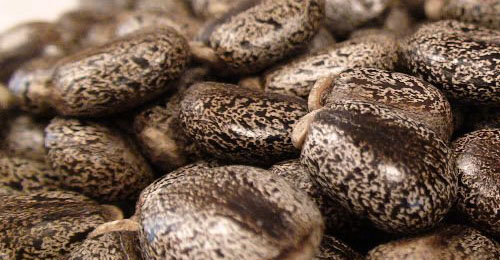
The first article here is from Science Codex and reports on new research suggesting that triheptanoin, a novel medium chain triglyceride with odd chain fatty acids, derived from Castor Bean oil, can reduce the debilitating epileptic seizures associated with Glut 1 deficiency, a rare metabolic disorder.
The cool thing is that the researchers want this oil to be declared a functional food and not a drug (although Baylor Research Institute has filed a patent on it for one particular use). Dr. Juan Pascual is an Associate Professor of Neurology and Neurotherapeutics, Physiology, and Pediatrics at UT Southwestern and lead author of the study, published in JAMA Neurology. He says, "This study paves the way for a medical food designation for triheptanoin, thus significantly expanding therapeutic options for many patients."
This article made me curious, so I did a Google search and found that this oil has shown efficacy in other forms of seizure disorders and as a possible early-stage treatment (as part of a ketogenic diet) for Alzheimer's Disease.
Citations are below the main article.
Medicinal oil reduces debilitating epileptic seizures associated with Glut 1 deficiency
Posted By News On August 11, 2014
DALLAS – Aug. 11, 2014 – Two years ago, the parents of Chloe Olivarez watched painfully as their daughter experienced epileptic seizures hundreds of times a day. The seizures, caused by a rare metabolic disease that depleted her brain of needed glucose, left Chloe nearly unresponsive, and slow to develop.
Within hours, treatment with an edible oil dramatically reduced the number of seizures for then-4-year-old Chloe, one of 14 participants in a small UT Southwestern Medical Center clinical trial.
"Immediately we noticed fewer seizures. From the Chloe we knew two years ago to today, this is a completely different child. She has done amazingly well," said Brandi Olivarez, Chloe's mother.
For Chloe and the other trial participants who suffer from the disease called Glut1 deficiency (G1D), seizure frequency declined significantly. Most showed a rapid increase in brain metabolism and improved neuropsychological performance, findings that suggested the oil derived from castor beans called triheptanoin, ameliorated the brain glucose-depletion associated with this genetic disorder, which is often undiagnosed.
"This study paves the way for a medical food designation for triheptanoin, thus significantly expanding therapeutic options for many patients," said Dr. Juan Pascual, Associate Professor of Neurology and Neurotherapeutics, Physiology, and Pediatrics at UT Southwestern and lead author of a study on the findings, published in JAMA Neurology.
For the estimated 38,000 Americans suffering from this disease, the only proven treatment has been a high-fat ketogenic diet, which only works for about two-thirds of patients. In addition, this diet carries long-term risks, such as development of kidney stones and metabolic abnormalities.
Based on the results of this trial, triheptanoin appears to work as efficiently as the ketogenic diet; however, more research needs to be done before the oil is made available as a medical food therapy, researchers said.
A rare metabolic disease that caused hundreds of seizures daily for 6-year-old Chloe Olivarez is now significantly under control as part of a clinical trial led by Dr. Juan Pascual that uses a medicinal oil for treatment.
"Triheptanoin byproducts produced in the liver and also in the brain refill brain chemicals that we found are preferentially diminished in the disorder, and this effect is precisely what defines a medical food rather than a drug," said Dr. Pascual, who heads UT Southwestern's Rare Brain Disorders Program, maintains an appointment in the Eugene McDermott Center for Human Growth and Development, and holds The Once Upon a Time Foundation Professorship in Pediatric Neurologic Diseases.
The oil, approved for use in research only, is an ingredient in some cosmetic products and is added to butter in some European countries. It is not commercially available in the U.S. for clinical use.
Triheptanoin's success as an experimental treatment for other metabolic diseases, along with preclinical success in G1D mice, led Dr. Pascual and his trial collaborator, Dr. Charles Roe, Clinical Professor of Neurology and Neurotherapeutics, to first conceive the idea and then launch this trial for G1D patients. The 14 pediatric and adult patients in the study consumed varying amounts of the oil, based on their body weight, four times a day. Given the trial's success, Dr. Pascual plans further research to refine the optimal dosage toward the goal of facilitating medical food designation of triheptanoin as a new G1D treatment.
While some trial participants reported mild stomach upset as a side effect, for Chloe the oil has been a miracle medicine without negative effects. Her parents, Brandi and Josh Olivarez of Waco, Texas, continue to be amazed by her progress.
"Before, she was having so many seizures a day that she couldn't even talk. Now she sings all the time, she can eat whatever she wants, and her speech is greatly improved. She still has some learning delays, but has come a long way," said Mrs. Olivarez.
Many Glut1 patients suffer from movement disorders that limit their physical capabilities, but that does not appear to be the case with Chloe. As for the seizures, she still has minor ones occasionally, but they are not debilitating.
"She is now able to run a solid mile without stopping. This would not have been possible without the oil," Mrs. Olivarez said. "Before, she had almost no muscle tone, was lethargic and had a very wide gait due to trying to balance herself while walking, which was very tiring for her."
To better understand this disease, UT Southwestern established a patient-completed registry to track G1D incidence and what treatments work or do not work for those registered.
Study author Dr. Hanzhang Lu, Associate Professor in the Advanced Imaging Research Center and of Psychiatry and Radiology, a TI Scholar in Advanced Imaging Technologies, devised a novel MRI technique used in the trial to measure brain metabolism.
(Photo Credit: UT Southwestern)
Source: UT Southwestern Medical Center
Other research:
Aso, E, Semakova, J, Joda, L, Semak, V, Halbaut, L, Calpena, A, Escolano, C, Perales, JC, and Ferrer, I. (2013, Mar). Triheptanoin supplementation to ketogenic diet curbs cognitive impairment in APP/PS1 mice used as a model of familial Alzheimer's disease. Current Alzheimer Research; 10(3):290-297. DOI: 10.2174/15672050112099990128 [abstract]McDonald, T, Hodson, M, and Borges, K. (2014, Apr). Triheptanoin alters anaplerosis and glutamate production in the chronic pilocarpine model of epilepsy (LB78). The FASEB Journal; 28(1): Supplement LB78. DOI: 10.1096/fj.1530-6860 [abstract]
Borges, K, Sonnewald, U. (2012, Jul). Triheptanoin--a medium chain triglyceride with odd chain fatty acids: a new anaplerotic anticonvulsant treatment? Epilepsy Res.; 100(3):239-44. doi: 10.1016/j.eplepsyres.2011.05.023 [full text]
Hadera, MG, Smeland, OB, McDonald, TS, Tan, KN, Sonnewald, U, and Borges, K. (2014, Apr). Triheptanoin partially restores levels of tricarboxylic acid cycle intermediates in the mouse pilocarpine model of epilepsy. Journal of Neurochemistry; 129(1): 107–119. DOI: 10.1111/jnc.12610 [abstract]

No comments:
Post a Comment